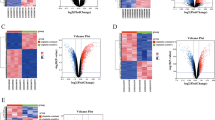Abstract
Objective: To screen novel genes related to adriamycin (Adr) resistance from human ovarian cancer resistance cell line OC3/Adr. Methods: Multidrug resistant ovarian cancer cell line OC3/Adr was induced by intermittent treatment of the human parent cell line OC3 with high concentration Adr. The difference of gene expression was screened by using different display analysis to the acquired Adr-resistance subline OC3/Adr and its parent cell line OC3. Results: OC3/Adr cell line was obtained which was more resistance to Adr than the parent cell line OC3 with the resistance index (RI) of 15.4. The OC3/Adr cell line also showed cross-resistance to other anti-cancer drugs (VP16, CDDP,5FU). It grew slowly and exhibited changes of cell cycle. A number of differentially expressed ESTs (Expressed Sequence Tags, ESTs) were identified at mRNA level between the OC3/Adr and OC3. Four of 18 different ESTs were sequenced. The 431/432 base pair S1 was homologous to human sperm zona pellucida binding protein, while the other two ESTs, S3 and S4, were new gene segments, which were registered to GenBank with the number of AF 117656 and AF 126507 respectively. Particularly, the expression of S2 sequence increased in all the drug-resistance cell lines and S3 sequence overexpressed in human ovarian cancer tissues as compared with benign ovarian tumors. Conclusion: Drug resistance induced by Adr in ovarian cancer OC3/Adr is involved with changes of multiple gene expressions.
Similar content being viewed by others
References
Van der Zee AJ, Hollema HH, de Bruijn HW, et al. Cell biological markers of drug resistance in ovarian carcinoma[J]. Gynecol Oncol 1995; 58: 165.
Sood AK, Buller RE. Drug resistance in ovarian cancer: from the laboratory to the clinic[J]. Obstet Gynecol 1998; 92: 312.
Ozols RF, Vermorken JB. Chemotherapy of advanced ovarian cancer: currents status and future directions[J]. Semin Oncol 1997; 24(Supp 12): 1.
Coukos G, Rubin SC. Chemotherapy resistance in ovarian cancer: new molecular perspectives[J]. Obstet Gynecol 1998; 91: 783.
Liang P, Pardee AB. Differential display of eukaryotic messenger RNA by means of the polymerase chain reaction[J]. Science 1992; 257: 967.
Lautier d, Canitrot Y, Deeley RG, et al. Multidrug resistance protein (MRP) gene[J]. Biochemical Pharmacal 1996; 52: 967.
Loe DW, Deeley RG, Cole SPC, et al. Biology of the multidrug resistance-associated protein, MRP[J]. Eur J Cancer 1996; 32A: 945.
Scheffer GL, Wijnraard PLJ, Flens MJ, et al. The drug resistnace-related protein LRP is the human major vault protein [J]. Nature Med 1995; 1: 578.
Izquierdo MA, Van D, Zee AG, et al. Drug resistance-associated marker LRP for prediction of response to chemotherapy and prognoses in advanced ovarian carcinoma[J]. J Natl Cancer Inst 1995; 87: 1230.
Khalifa MA, Abdoh AA, Mannel RS, et al. P-glycoprotein as a prognostic indictor in pre-and postchemotherapy ovarian adenocarcinoma[J]. Int J Gynecol Pathol 1997; 16: 69.
Keith WN, Stallard S, Brown R, et al. Expression of mdr1 and GSTπ in human breast tumors: comparison to in vitro chemosensity[J]. Br J Cancer 1990; 61: 712.
Eliopoulos AG, Kerr DJ, Herod J, et al. The control of apoptosis and drug resistance in ovarian cancer: influence of p53 and Bcl-2 [J]. Oncogene 1995; 11:1217.
Perego P, Giarola M, Righetti SC, et al. association between cisplatin resistance and mutation of p53 gene and reduced bax expression in ovarian carcinoma cell systems[J]. Cancer Res 1996; 56: 556.
Mok SC, Wong KK, chan RK, et al. Molecular cloning of differentially expressed genes in human epithelial ovarian cancer[J]. Gynecol Oncol 1994; 52: 247.
Anisowicz A, Sotiropoulou G, Stenman G, et al. A novel protease homolog differentially expression in breast and ovarian cancer[J]. Mol Med 1996; 2: 624.
Sedlak J, Sedlakova O, Hlaveak P, et al. Cell surface phenotype and increased penetration of human multidrug-resistance ovarian carcinoma cells into in vitro collagen-fibroblasts matrix[J]. Neoplasm 1996; 43: 38.
Author information
Authors and Affiliations
Corresponding author
Additional information
Foundation item: This work was supported by the National Natural Science Foundation of China(No. 39870784) and the Post-Doctor Foundation of China (No. 98623).
Biography: Tian Fang (1958–), doctor of medicine, associate professor, Laboratory of Onco-molecular Biology, Institute of Military Medical Sciences, Beijing, majors in tumor immunology.
Rights and permissions
About this article
Cite this article
Tian, F., Zgheng, Gj., Zhou, Hs. et al. Screening of drug resistance-related genes from human ovarian cancer cell line OC3/ADR by DD-PCR. Chin. J. Cancer Res. 13, 83–87 (2001). https://doi.org/10.1007/s11670-001-0020-1
Received:
Accepted:
Issue Date:
DOI: https://doi.org/10.1007/s11670-001-0020-1




